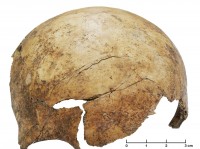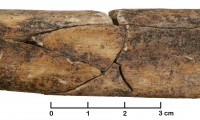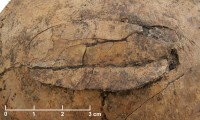 A mass grave discovered during road work in Schöneck-Kilianstädten, near Frankfurt, Germany, in 2006 is evidence of a massacre in a community of Early Neolithic farmers. The human remains were discovered by construction workers who alerted the University of Mainz to the find. Bioarchaeologist Christian Meyer and his team removed the bones in blocks of soil so they could be fully excavated and studied in laboratory conditions at the university. Radiocarbon testing of the skeletal remains found they date to between 5,207 and 4,849 B.C. That places them squarely in the Linearbandkeramik, or Linear Pottery, Culture (LBK) which flourished in central Europe from 5,500 to 4,500 B.C.
A mass grave discovered during road work in Schöneck-Kilianstädten, near Frankfurt, Germany, in 2006 is evidence of a massacre in a community of Early Neolithic farmers. The human remains were discovered by construction workers who alerted the University of Mainz to the find. Bioarchaeologist Christian Meyer and his team removed the bones in blocks of soil so they could be fully excavated and studied in laboratory conditions at the university. Radiocarbon testing of the skeletal remains found they date to between 5,207 and 4,849 B.C. That places them squarely in the Linearbandkeramik, or Linear Pottery, Culture (LBK) which flourished in central Europe from 5,500 to 4,500 B.C.
The bones were in very poor condition, most of them in fragments, but researchers were able to determine that the deceased had not been laid to rest in a respectful manner. There were no grave goods — a common feature in Neolithic burials — and no articulated remains. The bones of at least 26 people — 13 adults, one teen, two preteens and 10 children under six years old — were mixed up together in the one grave, indicating they had been thrown into a pit in a haphazard manner. Osteological analysis found extensive perimortem blunt force and arrow injuries on the bones. Arrowheads were also found amidst the remains. These people were slaughtered and then dumped in a mass grave.
 This isn’t the first LBK massacre site discovered. Similar graves have been found in Talheim, Germany, and Asparn/Schletz, Austria, but the bones from the Schöneck-Kilianstädten show signs of mutilation that has not been detected at the other sites: the deliberate breaking of legs. More than half of the shin bones were intentionally broken, either by torture just before the victims died or by mutilation immediately after death.
This isn’t the first LBK massacre site discovered. Similar graves have been found in Talheim, Germany, and Asparn/Schletz, Austria, but the bones from the Schöneck-Kilianstädten show signs of mutilation that has not been detected at the other sites: the deliberate breaking of legs. More than half of the shin bones were intentionally broken, either by torture just before the victims died or by mutilation immediately after death.
All three LBK massacre sites date to around the same time and archaeologists have found no evidence that people of another culture were involved in the mass killings. This appears to be LBK-on-LBK violence.
 LBK people were the first farmers in central Europe and the later age of the massacre sites suggest the populations may have come under pressure leading to escalating conflict and violence. No younger women were found in the Schöneck-Kilianstädten or the Asparn/Schletz graves, which could indicate a Sabine women-style abduction scenario. As for what the pressures may have been that spurred communities to violence, the study authors hypothesize that it was a combination of factors. From the paper published in the Proceedings of the National Academy of Sciences:
LBK people were the first farmers in central Europe and the later age of the massacre sites suggest the populations may have come under pressure leading to escalating conflict and violence. No younger women were found in the Schöneck-Kilianstädten or the Asparn/Schletz graves, which could indicate a Sabine women-style abduction scenario. As for what the pressures may have been that spurred communities to violence, the study authors hypothesize that it was a combination of factors. From the paper published in the Proceedings of the National Academy of Sciences:
Although the underlying supraregional causes for the recognized increase in mass violence in the late LBK undoubtedly were complex and multifactorial, a significant increase in population followed by adverse climatic conditions (drought), possibly coupled with the inability of long-settled farmers to practice the avoidance behavior by which hunter-gatherers typically evade conflict, seem to have been important components of the overall picture.